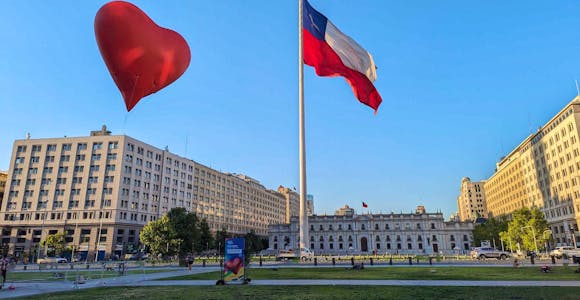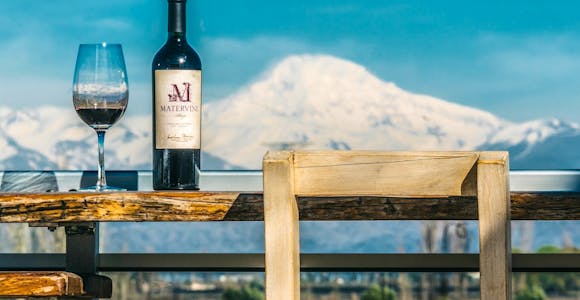
Santiago
Chile’s cosmopolitan capital is a great place to explore, from its rich heritage and views of the Andes to its easy access to fantastic wineries.
Discover MoreDeep roots in Patagonia: We are ex-guides, tour leaders, outdoor enthusiasts, & adventurers.
We’ve got our feet on the ground: Impartial advice, a bespoke service, and at no extra cost.
For the ends of the Earth: Sustainability is more than our carbon footprint (but we’re reducing that too).

Easter Island—known as Rapa Nui to its original inhabitants—is a tiny speck in the Pacific Ocean, and Chile’s most far-flung outpost. This is the home of the moai, the monumental statues that are the guardians of this ancient tropical island, and whose silent stares continue to evoke wonder in generations of travellers.

Unravel the mysteries of Rapa Nui, the most isolated—populated—island on Earth... You'll travel 2,180 miles from Santiago across the Pacific to this remote Polynesian paradise. Explore a vibrant culture, ancient traditions, and the famous moai statues that make this such…

4.6 out of 5
Explore this remote and mysterious Chilean island and take in unique, majestic sites including archaeological remains, caves, petroglyphs and natural wonders. Discover the main sites of this small island located in the middle of the Pacific Ocean and soak up…
Easter Island from the air
Easter Island's moai
Easter Island is a Special Territory of Chile and one of the most isolated inhabited islands in the world. It is 3760 km (2340 miles) west of Santiago, a tiny dot in the Pacific Ocean measuring just 22 km (14 miles) long.
Rapa Nui (the indigenous name for Easter Island) was first settled around 1300AD by people arriving from the Polynesian Marquesa Islands. These first settlers and their descendants were responsible for the construction of the nearly 900 giant stone figures called moai that are dotted across the island. The moai are repositories of spiritual power, and were ‘walked’ upright into position using a sophisticated system of ropes.
The popular myth that the Rapa Nui people doomed their own civilisation to ecological suicide by deforesting Easter Island has been shown to be a myth by recent archaeological and genetic studies.
Although many of the Rapa Nui people never survived first contact with European cultures, around 60% of Easter Island's population today is proud to claim indigenous descent.
The most spectacular collection of moai on Easter Island are found at Ahu Tongariki on the eastern coast. Fifteen enormous moai stand in line on a platform – the largest ceremonial site on the island and a truly dramatic assemblage. Nearby petroglyphs show a turtle with a human face as well as a birdman, an important cult figure in Rapa Nui culture.
It’s worth being an early riser for a visit to Ahu Tongariki: their location becomes even more spectacular at sunrise, when the sun breaks out of the Pacific Ocean behind them to cast them all in a magical light.

Ahu Tongariki
The best place to explore the origins of the moai is at Rano Raraku, a quarry close to Ahu Tongariki, where you can see where the giant statues were hewn from the volcanic tuff, without any metal implements.
It’s one of the most evocative sites on Easter Island. The green hillside here is dotted with dozens of moai in all stages of carving, from the barely begun to almost finished. There’s a very real sense of walking into a construction zone that’s been abandoned halfway through a project, and it's impossible to leave Rano Raraku without being impressed at the skills and dedication needed to erect such incredible monuments.

Moai heads at Rano Raraku quarry
The gentle pace of island life washed over me the moment my plane touched down and I was given a traditional Polynesian garland of flowers to wear – but the giant moai statues immediately woke me back up. They're so much more extraordinary up close than I could ever have imagined.
Sydney Miller Patagonia Specialist
The southwestern tip of Easter Island is dominated by the enormous Rano Kau crater, which is the collapsed remnant of a once-powerful volcano. It’s a great place for hiking and wonderful views out across the Pacific Ocean.
Close at hand, Orongo ceremonial village was once an important site for Rapa Nui’s birdman cult, where young men would compete to collect the first seabird eggs of the season from a small island offshore. The first to swim the back with an egg and scale the cliffs of Rano Kau won great honour for their clan.
Please note that a natural rockfall in November 2025 means that it is not currently possible to access Orongo, though you still hike at Rano Kau for the views.

Rango Kau crater
Ahu Tahai is one of the most picturesque spots on Easter Island. It’s a collection of three ahu platforms topped with moai, around the remnants of an ancient village. The moai stand on the edge of a western-facing cliff framed against the sea. There is no better place on the island to watch the sunset on the island: it’s truly dazzling, and is just a short walk from Hanga Roa town.
The northernmost moai is called Ahu Ko Te Riku and is unique on the island. Not only is it a rare example of a statue wearing a pukao (topknot), which is carved from red volcanic rock, it’s the only moai that still has eyes. These are made from white coral and obsidian, and signify a moai that has come to life to spread its spiritual power over the land it surveys.

The moai at Ahu Taihai
No trip to a tropical Polynesian island should be considered complete without a little beach time. Anakena on the north coast is a gentle cove with all the white sand and palm trees you’ll need to indulge any desert island fantasies.
Oral traditions recount that it was at Anakena where the founder of Rapa Nui first landed, led by their leader Hoto Mat’ua. The beach is overlooked by Ahu Ature Hoki, a group of moai re-erected by the local community with explorer Thor Heyerdah in 1958, which were the first moai to be re-erected in modern times.

Anakena Beach
Easter Island doesn’t just have to be about its ancient culture and its beaches. There are a variety of adventure activities on offer as well. One of the best is to hire an ATV. There are only a couple of roads on the entire island, but it’s a fun way to explore independently, especially to get to the beach. Horse riding and mountain bikes offer alternative ways to get around.
For a different perspective, it’s possible to go out by boat for snorkelling or just to see the dramatic coastline from the water, or got underground in the Tahai caves.

Snorkel boat off Easter Island
All of Easter Island is considered a national park, and all the main sights require a private guide to visit except those in Hanga Toa town (including Ahu Tahai) and Anakena beach
The lore and the beauty and mysticism on the island is magical. I also liked that there were very few tourists there. We had great weather and people were friendly, even though I didn’t speak Spanish. Read the full review
Travelled: June 2025
Ronald Allen Lenehan - USA
Easter Island Explora was amazing. It was truly amazing and the whole experience top notch. From amazing guides, food, service and room. Read the full review
Travelled: September 2024
James Andy - USA
Add Easter Island to the trip. If you are going that far it is worth it!!! Read the full review
Travelled: November 2019
John Williams - United Kingdom
Despite its modest size, Easter Island has a good selection of places to stay, from simple hotels to all-inclusive luxury lodges.
The majority of the island’s accommodation is in Hanga Roa town on the western tip of the island, including one of our favourite lodges, Nayara Hangaroa.
To truly escape from everything Explora Rapa Nui offers tropical island seclusion run to the same high standards as the luxury lodge group’s properties in Patagonia.
All Swoop’s preferred hotels include optional guided excursions to Easter Island’s main sights.

Explora Rapa Nui
Sleepy Mataveri International Airport (code IPC) is on the outskirts of Hanga Roa town.
There is at least one daily direct flight connection to Santiago with LATAM (4½ hours), with two and sometimes three flights a day in high season.
LATAM is the only airline that serves Easter Island. This, plus the island's ocean location, help explain why this is considered one of the most remote destinations in the world.
Prior to the Covid-19 pandemic there were direct flights from Easter Island to Papeete (Tahiti), but there are currently no plans for this service to resume.

Mataveri Airport, Easter Island
Patagonia is a vast and varied region, with a wealth of things to see and do, a range of places to stay and a limited transport network.
Tap into 400,000 hours of lived experience. As guides, guardians and travellers, we know these incredible places intimately and care about them deeply. From a world of options, we'll help you discover your perfect adventure.

Chile’s cosmopolitan capital is a great place to explore, from its rich heritage and views of the Andes to its easy access to fantastic wineries.
Discover More
Chile's Atacama Desert is one of the driest places on Earth, but it's extraordinary diversity of landscapes make it the ideal add-on to a Patagonia adventure.
Discover More
Mendoza is Argentina’s greatest wine region, best explored with a glass of malbec from one of its many vineyards, or as a base for hiking on Mount Aconcagua.
Discover More
Torres del Paine National Park, with its iconic granite Towers, is one of Patagonia's most popular destinations: a paradise for hikers and outdoor adventure activities.
Discover MoreWe'll spend some time listening to your aspirations, then discuss the kind of experience that might suit you.
Next we'll discuss the options, shortlist the best trips for you and present you our impartial recommendations.
We'll place a 24 hour hold on your preferred option - without obligation - whilst we talk through the details.
This website uses cookies to ensure you get the best experience on our website. Privacy policy